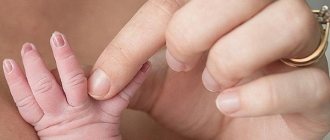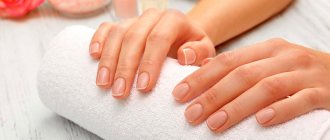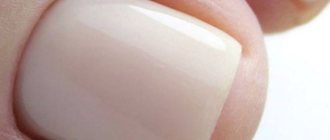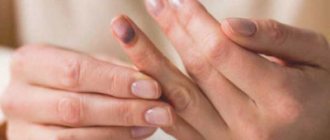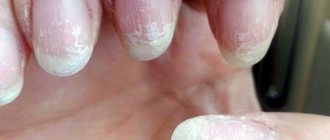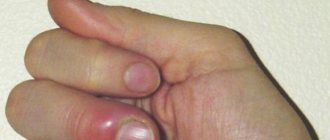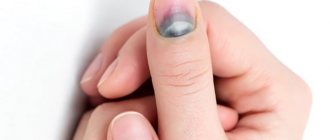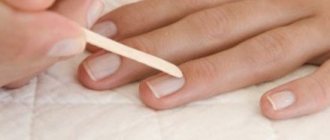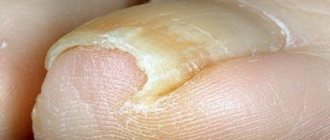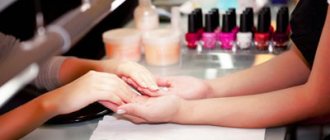An abscess on the finger is called felon. When the inflamed area is located near the nail plate, they speak of paronychia. The pathology develops as a result of microtraumas in the nail area (bruises, cuts, injections). In most cases, the disease occurs on the fingers.
The disease progresses due to pathogenic bacteria that enter the body through damaged tissue. The proliferation of pathogenic microorganisms occurs faster if a person’s immunity is weakened due to illness or a lack of substances necessary for the body. In order to help the immune system, wounds are treated with antiseptics. If inflammation or swelling is ignored, suppuration develops.
Possible causes of an abscess
- A purulent abscess on the finger often occurs due to the habit of biting nails. A child’s teeth damage the skin, allowing pathogenic bacteria to enter the body.
- The finger is festering due to hangnails. Since children's skin is very delicate, even a small defect in the skin near the nail allows dirt to penetrate the body.
- The inflamed area breaks out due to the pliability of the nail plate in infants. If you trim your nails incorrectly or carelessly, you can deform the nail, which can lead to it growing into the skin. This, in turn, leads to tissue inflammation.
Features of treatment in children
If you notice an abscess on your child's finger, be careful. The fact is that not all remedies and treatment methods that are suitable for adults can have a positive effect in children. If the condition worsens, you should immediately contact a specialist.
If a wound appears on the side of the finger, you need to treat the damaged area with antiseptics to prevent the development of the disease. To eliminate swelling, steaming the affected finger in a solution of soda, potassium permanganate or salt is suitable.
If a child has ingrown nails into the skin, tamponade is performed. This procedure takes place in several stages. First, your hands are steamed in a warm soda solution. Next, the ingrown nail is pulled back using a sterile instrument, and a piece of gauze soaked in any antiseptic is placed under the pulled-back section of the nail plate. After which the finger is bandaged.
Drug therapy
The choice of treatment method and medications depends on the degree of neglect of the disease and the time that has passed since the onset of felon development. In the early stages, further development of the pathology can be prevented at home using the folk remedies discussed below.
If the child suffers from severe throbbing pain and the swelling does not subside, you should seek help from a surgeon. The specialist will examine the baby, make a diagnosis and prescribe treatment. Abscesses are treated using the following means:
- Levomekol is an antibiotic-based ointment. It draws out pus well. After disinfection, apply to the inflamed area.
- Ichthyol ointment. It is applied to the pathological area. It has the ability to penetrate deep into the skin, where it kills pathogenic bacteria, soothes and reduces inflammatory processes, relieving swelling and reducing pain.
- Antifungal ointments. Used when the fungus penetrates the affected tissues. The following drugs are suitable for children: Mikozan, Batrafen, Demikten, Belvedere. Before applying the product to the nail, the damaged areas are filed off with a nail file.
Folk remedies
Folk remedies are best used in the early stages of the disease, as they will not help cure complications. Such drugs are loyal to the immune system and usually do not cause side effects.
For a small cut, improvised means such as ice or any item in the freezer will help. Using it, a cold compress is applied to the problem area. Cold slows down metabolism, thereby stopping the inflammatory process. This compress will also reduce pain and swelling.
You can neutralize germs, relieve swelling and draw out pus using a bath with saline solution (1 tbsp per glass of warm water).
Other effective folk remedies include:
- Baths with furatsilin solution. Place the baby's sore finger in the bath for 10-15 minutes, then rinse and bandage with a loose, not very tight bandage.
- Applications with blue clay, which has the property of drawing pus from the wound, while simultaneously disinfecting the affected area. It also has a bactericidal effect, so it can be applied to an open wound. The clay is applied to a bandage, which is applied to the disturbing area. This compress should be kept for 3-4 hours, after which the area of skin that was under the bandage is washed and sealed with a sterile bandage.
Baked onions are a very effective remedy for purulent abscesses.
- Baked onion compress. You should bake the onion in the oven or microwave, cut out the core so that your finger can fit there. The problematic finger is placed in the bow and fixed in this position with a bandage. The bandage should be kept on for 3 hours, after which you need to wash your hands and bandage your finger.
- Beetroot compress. Before the procedure, the damaged nail must be disinfected (you can keep it in the saline solution discussed above). Apply finely chopped beets to the wound and bandage tightly. This bandage should be kept for 4-5 hours.
- Treatment of abscess with herbal decoctions. Our ancestors also engaged in gathering and treated diseases with medicinal plants. To prepare a decoction, you need herbs with antiseptic properties that help remove inflammation (chamomile, St. John's wort, plantain leaves, sage, lilac inflorescences). To a decoction of 2 tbsp. herbs and 400 ml of boiling water, add a large pinch of soda. Keep your finger in the warm solution for 10-15 minutes.
If pus appears under the nail during or after the procedures, it is better to squeeze it out. This will contribute to the baby’s speedy recovery.
In what cases is surgery required?
What to do if the patient does not recover, and the damaged area festers even more? A surgeon comes to the rescue. He examines the small patient and then operates on the problem area. The pus is cut out from the wound, then it is washed with an antiseptic solution. After the operation, the finger is bandaged, the sterile bandage is changed 3-4 times a day.
Possible complications
If treatment is not started in time, rotting can affect fatty tissues or tendons. In this case, there is a possibility of developing blood poisoning. First, the temperature rises - the body fights infection. The next stage is the appearance of pathogenic microorganisms in the blood and urine. If measures are not taken in a timely manner, internal organs may fail, resulting in death.
Our hands come into contact with many objects and liquids every day. Although nature has made sure that the skin of the hands is denser and the fingertips are protected by the nail plates, damage cannot always be avoided.
Infection can easily penetrate through minor injuries that are not given importance. After a few hours or days, the presence of a focus of inflammation or an abscess can be detected.
Particular caution should be exercised if a purulent abscess appears on the finger near the nail. This is the so-called paronychia or periungual panaritium.
It would seem like a banal inflammation, but a purulent abscess is a very insidious disease. In particularly advanced cases, there is a high probability of losing a finger or an entire limb. If left untreated, paronychia can cause severe complications, including microbial blood poisoning and the development of sepsis.
Causes of an abscess near the nail
An abscess near the nail can occur at any age. Gender also does not matter much, although it is believed that paronychia is more common in women.
This is due to the fact that the female half of the population more often gets their nails done and does everyday housework. This serves as a prerequisite for more frequent traumatic effects on the cuticle and skin of the fingers.
The reasons that cause purulent inflammation near the nail are as follows:
- Damage to the cuticle when performing a manicure. This especially often occurs when a manicure is trimmed, when too much tissue is cut off. Microwounds become entry points for infection, and purulent inflammation develops.
- Habit of biting nails or sucking fingers. This is especially true for children. In childhood, the occurrence of paronychia is not uncommon.
- Ingrown nail. This is most often observed on the legs. An ingrown toenail injures the periungual ridges, provoking an inflammatory reaction. When an infection occurs, suppuration occurs.
- Professions associated with constant microtrauma to the skin of the hands or the need to come into contact with liquids and chemical agents: mechanics, hairdressers, cooks, cleaners, dishwashers, builders, orderlies, etc.
- Presence of internal diseases. For example, diabetes mellitus or vascular disease, when blood circulation in the fingers and toes suffers. At the slightest damage to the skin, long-healing wounds are formed.
- Paronychia can be fungal in nature, especially if a person suffers from nail fungus or skin fungus on the feet.
Symptoms and stages of abscess
Recognizing periungual felon, as a rule, does not cause difficulties even for people far from medicine. The symptoms of an abscess on the finger are very pronounced, and the abscess develops quickly and becomes noticeable to the naked eye.
Stages of development of paronychia:
- Swelling and infiltration.
- Suppuration.
In the first stage of the disease, severe swelling of the finger and redness are noted. The finger is warm or hot to the touch, sharply painful on palpation, pain is also noted at rest. Finger movements are impossible.
During the suppuration stage, the pain becomes unbearable and is often pulsating. During this period, body temperature may rise and weakness may occur. Near the nail, an area of accumulation of pus is visualized, which has a round or ribbon-like shape.
How to treat an abscess on a finger near the nail?
Unfortunately, people rarely come to a medical facility with the initial stage of an abscess near the nail. Most often, people try to treat it at home, underestimating the situation.
It is possible to treat an abscess on a finger using conservative methods only in the stage of infiltration and swelling, whether on the arm or leg. When pus appears, there is an urgent need to open the abscess and wash the wound.
Conservative treatment methods:
- Baths. The effectiveness of the baths depends on the time when the disease was discovered. The earlier treatment is started, the greater the chances of recovery. Baths of a weak solution of potassium permanganate will help relieve inflammation. The duration of the procedure is 20−30 minutes.
- Applying ointments. Vishnevsky ointment, Levomikol and Dioxidin ointment have proven themselves well in the treatment of paronychia.
- Taking antibiotics. The choice of antibacterial drugs when treating an abscess near the nail is made by a doctor. Taking antibiotics on your own is dangerous to your health!
- In the case of a fungal nature of the disease, antimycotic drugs are prescribed, which can be in the form of tablets, ointments or mash.
Surgical methods of treatment:
- Opening the abscess. The surgeon will apply local anesthesia and then use a scalpel to remove dead tissue. The wound is thoroughly washed, antibiotics are administered, and an aseptic dressing is applied.
- Removing an ingrown toenail.
An abscess on the finger near the toenail can be treated at home in the initial stage and only if it is not associated with an ingrown toenail.
If there is a problem with the nail growing into the periungual fold, only surgical treatment aimed at completely removing the nail plate will help.
The procedure is performed under local anesthesia. The doctor will remove the nail, administer antibacterial drugs, and apply a sterile bandage with healing ointment. You will need to wear bandages for a week. A new nail will grow in 6-8 months.
Surgical treatment of boils
If a child has a large boil on his arm that causes severe pain, it is opened. The operation to open the abscess is performed under local anesthesia, so it does not cause pain. The doctor (surgeon) excises the top of the boil and removes the accumulated pus using a syringe or catheter.
The operation to open the abscess is performed under local anesthesia
The cavity cleared of pus is washed with antiseptic solutions. An antibiotic (Levomycetin) and a rubber strip folded in several layers to drain the wound are injected into it. The rubber strip will not allow the wound to heal until all the pus has drained out. A bandage soaked in hypertonic sodium chloride solution is applied to the wound. A hypertonic solution will help the cavity quickly get rid of purulent-necrotic contents.
When the cavity is clean, the rubber strip is removed. A bandage with Vishnevsky ointment is applied to the wound. The surgeon initially treats the wound and bandages daily, and when the cavity is cleared, after 2-3 days.
Recommendations for the prevention of periungual felon
To prevent the appearance of purulent inflammation around your nails, you need to be more attentive to yourself and follow a number of simple rules:
- Immediately treat any damage to the skin of the hands and feet with antiseptic solutions (brilliant, iodine, chlorhexidine, hydrogen peroxide).
- Do a gentle manicure, do not pick off hangnails, and do not bite your nails.
- Trim your nails regularly, taking care to file down any sharp ends.
- All work involving water, contaminated objects or chemicals should be carried out using thick rubber gloves.
- Promptly remove splinters that have gotten under the skin or nails.
- Treat fungal diseases of nails and skin.
- Monitor the health of the body as a whole.
This is what an abscess near the nail looks like
Many people experience a sore finger near the nail and don’t know what to do. It would seem that a harmless abscess can fester, even leading to the development of sepsis. Essentially, an abscess is an inflammation of the skin and deep tissues underneath it. What to do if your finger breaks out, how to treat panaritium correctly so as not to cause complications, what medications and folk methods will help, we will consider in more detail.
Why does inflammation of the finger appear near the nail?
The finger near the nail may become inflamed due to:
- ingrown nail;
- diabetes mellitus;
- performing incorrect, unsterile manicure;
- development of fungus on the nails of the hands and feet;
- impaired blood circulation in the veins;
- a cut near the nail or nail fold, with dirt and dust driven under the skin, which often happens to people when working with wood or shavings.
Ingrown toenail
The cause of an abscess on the foot near the nail can be:
- impact, injury to the skin, cracks and dirt getting under it;
- wearing tight shoes, which leads to the appearance of an ingrown toenail, as well as to an abscess when the integrity of the skin is violated;
- the pedicure was of poor quality, as a result of which an infection penetrated into the wound or cut near the nail plate and developed.
What are the symptoms of an abscess?
Acute inflammation of the finger near the nail
The infection, penetrating under the skin near the nail, into the upper layer of the epidermis, begins its development. Swelling, redness, and itching appear on the skin. The area near the nail begins to hurt. The inflammatory process, penetrating deeper into the skin tissue, forms stripes of purulent blisters in it. When affected, the joint becomes hot, hard, inflamed, and the finger hurts and cannot bend. If the tendons and fatty tissue have festered, then the temperature may rise and your health may deteriorate.
Inflammation needs to be treated as quickly as possible.
Precautionary measures
It is not recommended to independently treat multiple and large boils in children. Antibiotics and sulfa drugs can only be used after consultation with a doctor and under his supervision. It is necessary to urgently consult a doctor if the boil quickly increases in size, causes severe pain and an increase in body temperature to 38°C or higher.
Boils in children are best treated under the close supervision of a physician.
A doctor's consultation is necessary when treatment of a boil is ineffective. Warning signs include enlarged and painful lymph nodes. Surgical opening of the boil is necessary if a bubble with purulent contents does not form at its top. This sign may indicate the development of an abscess or phlegmon.
What can an abscess on a nail cause?
An abscess on the finger leads to suppuration under the nail, redness, and throbbing pain. The nail may simply fall out. When the tendon becomes inflamed, cells die and the finger becomes less mobile. When the abscess becomes complicated—purulent inflammation spreads to the fatty tissue of the hand—the temperature rises, the hand hurts greatly, the fingers become stiff, and general health deteriorates. If the abscess becomes complicated, the development of sepsis is just around the corner. The body's reaction to infection and foreign body can be very different. Sepsis inevitably leads to death, so when an abscess appears, the problem cannot be ignored.
It is necessary to take measures to eliminate this disease.
How to treat an abscess?
As soon as suppuration appears and the soft tissues become swollen, you need to:
- treat your finger with potassium permanganate by preparing a bath and holding your finger in it for at least 10 minutes. The potassium permanganate solution should be light pink, prepare a bandage. Apply Levomekol ointment or dioxidine ointment, Vishnevsky to the site of inflammation to accelerate the maturation of the abscess and the flow of pus from the wound;
- bandage the inflamed area, remove the bandage after a day.
Note
You cannot take independent measures if small bubbles appear on the epidermis layer. If a fungus has penetrated the skin, then most likely it is herpes, the treatment for which is completely different, you need to consult a dermatologist.
It is also better to visit a surgeon if there is severe swelling of the finger, redness of the skin, tugging pain, or accumulation of pus under the nail.
How to treat an abscess with medications?
If the inflammation is severe, the temperature has risen, baths with potassium permanganate have not eliminated the abscess and tugging pain, then the doctor will treat the wound with Vishnevsky ointment, Levomikol and prescribe antibiotics (augmentin, clindamycin, metronidazole). If the nail plate is damaged by a fungus, use antimycotic and antifungal agents (pivazin, mycozolon, triderm, diflucan, orungal, lamisil).
Vishnevsky ointment and Levomikol
If the finger is narwhal and it is not possible to treat it on an outpatient basis, then it is necessary to treat the inflamed area as quickly as possible with any available antiseptics: brilliant green, alcohol, iodine, hydrogen peroxide, vodka, then apply Vishnevsky ointment to the wound. The main thing is to destroy the bacteria and prevent the infection from penetrating into the deeper tissues of the epidermis.
loading…
How is an abscess treated surgically?
My finger starts to itch
If treatment with conservative methods is unsuccessful, then the abscess near the nail must be opened, that is, operated on:
- Incise the area under the abscess.
- Remove dead tissue, clean the cavity from pus.
- Inject antibiotics intramuscularly.
- If necessary, remove the nail plate.
- Treat the wound with disinfectants and apply a sterile bandage. Typically, after surgery, the patient should visit the doctor within a week to monitor the results.
How to treat hangnails in infants - Got pregnant
A hangnail is a piece of peeling skin near the nail plate of the fingers or toes.
In young children, this phenomenon is associated with particularly delicate skin, which under the influence of external or internal factors can dry out and become vulnerable.
Often, the problem with hangnails can be eliminated at home by following simple nail care rules, as well as adequate hand hygiene.
How dangerous are hangnails in a child?
Hangnails on a child usually do not attract the attention of young mothers, but the site for mothers supermams.ru knows that in the absence of proper care they can create serious problems.
The skin on children's hands is especially delicate, but this does not stop them from playing actively, especially in the summer. Playing in the sandbox or making a masterpiece out of clay is the greatest pleasure for little fidgets. Or playing on playgrounds where you have to climb, jump, and sometimes you have to fall.
All this leads to small wounds and the formation of burrs.
At the same time, even with the onset of cold weather, delicate children’s skin is not “safe” from the appearance of hangnails. The skin dries and cracks if you do not constantly moisturize it and do not put mittens on your child. Or do not make sure that during active games with snow he does not remove them from the handles on his own.
If painful areas are not treated in time, problems may begin:
- the skin around the nail will become red,
- swelling may occur,
- Cases of suppuration are common.
Hangnails in a child: causes
We have already talked about what causes hangnails in little fidgets. Now let's take a closer look at why hangnails mostly appear in children:
- hands get injured
- the skin on the hands is dry,
- the child has a bad habit of biting his nails and the skin around them,
- the baby has metabolic problems,
- the child lacks vitamins - especially A, C,
- the diet is unbalanced, the nutrition is incorrect,
- poor hand care.
A few words about caring for a child’s hands
Usually everyone thinks about how to solve a problem when a child already has a hangnail. We will, of course, talk about what to do in this case on the website supermams.ru a little lower.
But, you see, it is better to prevent such a serious problem than to look for a solution to the problem later.
Trim your nails using special scissors, not clippers. Using clippers can result in irregularly shaped nails and deformation of the nail plate as the nails grow. Sharp corners will dig into delicate skin, gradually injuring it.
Do not trim children's nails to the very root, but leave a little at the tips . Otherwise, the delicate skin under the nails will be exposed and begin to harden, turning into hard areas. Children can pick them out (sometimes these areas crack spontaneously), resulting in painful wounds.
Too dry skin of a child must be lubricated with a nourishing and moisturizing baby cream, especially before going outside.
But the cause of dry skin in a child’s hands is not only external. Sometimes it is due to the fact that the baby drinks little clean water. Give him boiled water more often. Or the diet is simply unbalanced - there is not enough healthy food.
But all these are general recommendations, now let’s talk about what exactly to do if hangnails have already formed.
A child has hangnails on his hands: how to remove them?
When you trim your baby's nails, carefully remove the skin around the nail before it gets too rough.
After you have removed the burrs (steam your hands first!), be sure to fill these areas with hydrogen peroxide. Even if there are no wounds visible to the eye, this does not mean that microcracks cannot become infected.
If a child develops a hangnail on his finger, this is a reason to seek professional help from a doctor. The specialist will tell you which ointment to use.
Of course, parents often try to cure suppuration on their own, using a variety of methods. Sometimes peroxide, brilliant green, Levomekol, Vishnevsky balm, and potassium permanganate solution really help.
I would like to emphasize this point - it helps someone, but someone takes various methods for several days, and the situation only gets worse.
The most critical moment is suppuration, severe swelling of the finger . It can also get very hot.
In this case, you definitely need to consult a doctor, and not any decoctions, poultices or other folk miracle remedies! Because such symptoms can only indicate that the purulent process does not subside, but is developing strongly. All this can lead to serious health problems.
This is why you should not delay treatment of hangnails in children or neglect the help of doctors.
If treated incorrectly or untimely, an abscess can cause damage to internal organs and sepsis.
Why does it happen that simple methods of treating suppuration help some people, but not others?
The thing is that sometimes a fungal or bacterial infection gets into the child’s skin through a hangnail. And seemingly harmless burrs in this case lead to serious problems.
https://www..com/watch?v=xgRTxWnLHT0
That's why you can't ignore even small hangnails on a child!
_ _ Website supermams.ru – Supermoms
Source: https://zabereme.ru/kak-lechit-zausency-u-grudnichkov.html
If a child's finger is torn
An abscess on a finger in children is a common phenomenon. A splinter that is not removed in time or a cut that has festered leads to a similar problem. The infection quickly penetrates the wounds through dirty hands or feet and begins to quickly spread inside.
A child picks a nail
If a child begins to complain of pain in a finger, you need to take measures:
- prepare a herbal solution from chamomile, St. John's wort and calendula;
- ask the child to hold the inflamed area of the finger in the solution for 15-20 minutes. The solution can be prepared from potassium permanganate, after which the inflamed area should be wiped dry and treated with brilliant green. After 3-4 hours, check the condition of the finger.
If the inflammation does not go away and the swelling does not subside, you need to apply Vishnevsky ointment. Despite the pungent odor, the ointment actively fights bacteria, destroying their flora, and the abscess matures faster. You need to check the condition of your finger the next day.
Note
If the ointment does not help, there is no improvement, the swelling of the finger quickly spreads to neighboring areas, then you need to consult a surgeon urgently.
It is worth considering that during the first day after a cut and suppuration, only a small abscess on the finger can be eliminated. If after a day there is no improvement, the abscess does not go away, self-medication is unlikely to help, it is better to go to the doctor.
Features of treatment in children
If you notice an abscess on your child's finger, be careful. The fact is that not all remedies and treatment methods that are suitable for adults can have a positive effect in children. If the condition worsens, you should immediately contact a specialist.
If a child has ingrown nails into the skin, tamponade is performed. This procedure takes place in several stages. First, your hands are steamed in a warm soda solution. Next, the ingrown toenail is pulled back using a sterile instrument, and a piece of gauze soaked in any antiseptic is placed under the retracted area of the nail plate (we recommend reading: a baby has an ingrown toenail - what to do?). After which the finger is bandaged.
Drug therapy
The choice of treatment method and medications depends on the degree of neglect of the disease and the time that has passed since the onset of felon development. In the early stages, further development of the pathology can be prevented at home using the folk remedies discussed below.
If the child suffers from severe throbbing pain and the swelling does not subside, you should seek help from a surgeon. The specialist will examine the baby, make a diagnosis and prescribe treatment. Abscesses are treated using the following means:
- Levomekol is an antibiotic-based ointment. It draws out pus well. After disinfection, apply to the inflamed area.
- Ichthyol ointment. It is applied to the pathological area. It has the ability to penetrate deep into the skin, where it kills pathogenic bacteria, soothes and reduces inflammatory processes, relieving swelling and reducing pain.
- Antifungal ointments. Used when the fungus penetrates the affected tissues. The following drugs are suitable for children: Mikozan, Batrafen, Demikten, Belvedere. Before applying the product to the nail, the damaged areas are filed off with a nail file.
READ ALSO: Doctor Komarovsky about a rash in a child: reasons for its appearance on the body and face, palms, around the mouth, on the butt - what to do
Folk remedies
Folk remedies are best used in the early stages of the disease, as they will not help cure complications. Such drugs are loyal to the immune system and usually do not cause side effects.
For a small cut, improvised means such as ice or any item in the freezer will help. Using it, a cold compress is applied to the problem area. Cold slows down metabolism, thereby stopping the inflammatory process. This compress will also reduce pain and swelling.
Other effective folk remedies include:
- Baths with furatsilin solution. Place the baby's sore finger in the bath for 10-15 minutes, then rinse and bandage with a loose, not very tight bandage.
- Applications with blue clay, which has the property of drawing pus from the wound, while simultaneously disinfecting the affected area. It also has a bactericidal effect, so it can be applied to an open wound. The clay is applied to a bandage, which is applied to the disturbing area. This compress should be kept for 3-4 hours, after which the area of skin that was under the bandage is washed and sealed with a sterile bandage.
READ ALSO: Shingles (herpes): symptoms and treatment
In what cases is surgery required?
What to do if the patient does not recover, and the damaged area festers even more? A surgeon comes to the rescue. He examines the small patient and then operates on the problem area. The pus is cut out from the wound, then it is washed with an antiseptic solution. After the operation, the finger is bandaged, the sterile bandage is changed 3-4 times a day.
Will folk recipes help with abscesses?
Traditional recipes are effective, as a rule, at the beginning of the development of the disease, or at the end, during the rehabilitation period, when foci of inflammation have already been suppressed. If you find yourself, for example, on a hike or outside the city, in the countryside, medications are simply not available. If your toe or hand breaks out, you can treat it with proven remedies:
- Combine the baked onion with grated laundry soap in a 1x2 ratio. Apply the pulp to the bandage, then to the site of inflammation. Change the bandage every 3-4 hours.
- Prepare a bath of iodine (10 drops) and salt (1-2 tablespoons), dissolving them in a glass of warm boiled water. Keep the sore finger in the solution for 15-20 minutes; after the epidermis softens, the pus will flow out. Next, you can apply Levomekol ointment and bandage it.
Iodine is very beneficial for your marigolds
- The pus comes out well when a honey cake is applied to the affected area, which can be prepared from honey and flour. Apply to the sore spot, bandage it, leave for 10 hours. The pus should disappear and the wound should cleanse.
- To reduce pain, relieve swelling, inflammation, prepare a vegetable ointment by grating carrots, onions and beets, adding aloe (juice). Apply the composition to the inflamed area.
- If your finger is inflamed, you can pick a regular leaf of plantain, coltsfoot, wrap it around the swollen area or twist it. Apply the pulp to the site of inflammation, the juice should draw out the pus.
- To speed up the maturation of an abscess and reduce pain, you can boil an onion in milk and apply an onion petal to the abscess.
- It is good to add interior fat to the baked onion. It can be bought at a pharmacy. Apply to the site of inflammation, change the bandages every 4-5 hours.
Do not allow a minor lesion on the skin to develop into a whitlow or a severe abscess. As recommendations, I would like to remind and warn that an ordinary splinter or a minor cut can lead to serious complications, rotting of the nail plate, penetration of infection inside, up to the development of sepsis, and amputation of a finger.
- Splinters must be removed carefully, promptly treating open wounds with any antiseptics.
- If a wound appears on your arm or leg while hiking, you can apply a clean plantain leaf. At the first stages of the development of the disease, it will definitely help.
- When traveling outside the city or to the dacha, you should always have a first aid kit (antiseptics, painkillers, Vishnevsky ointment, Levomekol, bandage, adhesive plaster). No one is immune from cuts, abrasions and splinters when performing gardening work.
- You should not allow dirt to get into wounds, which means you need to wash your hands more often and teach your children to do the same.
- Nails should be trimmed carefully, leaving the nail plate of sufficient length. Trimming your nails to the very root can end badly. If you prick yourself with a fish bone, immediately treat the wound with a solution of potassium permanganate, brilliant green, and ointment. Understand that for an abscess, it is enough for the smallest particles of dirt to get under the skin. When removing a splinter near the nail, lubricate the area with antiseptics.
Microbes should not be allowed to penetrate the skin and cause inflammation. An abscess on a finger or toe is unpleasant, but felon can be avoided by following preventive measures and knowing how to eliminate this disease.
loading…
Similar articles
An abscess on the finger is a common situation. People of all ages face this problem. With an abscess (or felon in medical parlance), not only the skin, but also deep tissues become inflamed.
Perhaps not everyone knows how to properly treat an abscess on a finger or toe. Delay or wrong actions can lead to disaster. In advanced cases, suppuration reaches the tendons and fatty tissue, and sepsis develops. Find out how to get rid of felon quickly and without complications.
- Causes
- Symptoms and stages
- Treatment methods
- Traditional methods and recipes
- Drug therapy
- Surgery
- Abscess on a child's finger
- Preventative tips
Causes
Provoking factors:
- onychomycosis – fungus on the feet and nails;
- violation of venous circulation;
- ingrown nail;
- improper manicure/pedicure;
- cuts, abrasions in the area of the nail fold, near the nail and fingertip;
- diabetes.
Note! Often, abscesses on the fingers occur in people engaged in manual labor. While performing professional duties, it is easy to get hurt, get a splinter, scratch your finger, prick yourself with a fish bone, and so on. Dirt, dust, technical oils will complete the “dirty deed.”
An abscess on the toe appears:
- after an impact, injury to the skin with further penetration of dirt;
- as a consequence of an incorrectly performed pedicure when infection penetrates into wounds, cuts, under unprotected skin next to the nail plate;
- When wearing tight, uncomfortable shoes, not only an ingrown toenail can appear, but also an abscess if the integrity of the skin is compromised.
Symptoms and stages
There are several stages of the inflammatory process:
- after infection penetrates into the upper layers of the epidermis, the skin turns red, swells, painful sensations and itching appear;
- the spread of the inflammatory process into the deep layers of the dermis is accompanied by the formation of a strip or bubble with pus inside;
- throbbing, twitching pain appears;
- the finger stops bending, the affected joint feels hot and hard to the touch;
- when fatty tissue and tendons suppurate, health worsens and the temperature often rises.
Types of felon:
- cutaneous and subcutaneous;
- periungual;
- subungual;
- tendinous.
Treatment methods
How to treat an abscess on a finger near the nail? In the first stages of the disease, conservative treatment under medical supervision is recommended. Severe, advanced cases require surgical intervention.
At the first signs of suppuration of soft tissues, swelling, mild pain, begin treatment:
- prepare a bath with potassium permanganate. Dissolve a few crystals in warm water until a light pink tint is obtained, and lower the sore finger. Carry out the procedure for 5–10 minutes;
- gently pat the skin dry. Fold the bandage, lubricate it with Vishnevsky ointment, Levomikol, Dioxidine ointment, and apply it to the inflamed area. These drugs actively accelerate the maturation of the abscess, after which pus flows out of the wound;
- bandage the sore spot, but not too tightly. See what the results are in a day or two.
Important! If you find not only swelling and redness of the tissues on the epidermis, but also small blisters, do not do anything on your own. Perhaps this is a fungal disease or the herpes virus is active on the skin. Treatment methods will be different. Improper actions contribute to the penetration of fungi into new areas.
Be sure to visit a surgeon if:
- your health has worsened;
- twitching pain appeared;
- the finger is more swollen;
- the skin is red;
- Pus accumulates under the nail, in the subcutaneous tissue or under the nail fold.
We offer you to read an interesting article about the beneficial properties and use of aloe in cosmetology.
How to prepare rose water for face at home? The best recipes are described on this page.
Traditional methods and recipes
Is it possible to treat an abscess using traditional medicine recipes? Certainly!
There is one condition - medicinal herbs and homemade ointments are recommended for the initial stage of the disease or if it is impossible to use medications, for example, during a hike. Treatment with home methods for old felon causes serious complications.
How to treat an abscess on a toe or hand? Proven recipes:
- baked onion. A simple home remedy speeds up the maturation of the abscess. Bake a medium onion, grate laundry soap. Combine shavings and chopped onion. Proportions – 1:2. Place the pulp on gauze and wrap it around the sore spot. Apply a fresh bandage every 4 hours;
- vegetable mixture from panaritium. Grate fresh beets, carrots, onions, take an equal amount of each component. Squeeze the aloe juice and add a few drops. Next, proceed as in the recipe with baked onions. The mixture reduces pain, relieves inflammation, reduces swelling;
- iodine-soda bath. As soon as you notice the first signs of an abscess on your finger or toe, prepare a water solution. To a glass of warm boiled water add 10 drops of iodine, 1 tbsp. l. soda, the same amount of regular or sea salt. Dip the sore finger into the solution and keep it for about twenty minutes. The epidermis will soften, the pus will come out more quickly;
- honey cake. An effective remedy that helps purulent discharge come to the surface. Thoroughly grind equal amounts of honey and flour. Wrap the resulting cake around the inflamed area, secure with a regular adhesive plaster, and cover with a bandage. The bandage can be removed only after 10–12 hours. At the initial stage, this time is often sufficient to remove pus;
- plantain or coltsfoot leaves. These medicinal plants are an excellent remedy for anyone who has an inflamed finger while staying out of town. Pick off the leaves and wrap them around the swollen area. You can prepare a paste, apply it, and top it with a bandage, napkin or handkerchief, whatever you find;
- milk onion. A folk remedy with a strange name reduces pain and accelerates the maturation of felon. Boil the onion in milk until soft, remove the plate and apply to the sore area. For greater effectiveness, apply a new petal of boiled onion every 5 hours;
- visceral fat. Buy unsalted fat at the pharmacy, combine with finely chopped baked onions, and apply to the inflamed area. Change the dressing every 5–6 hours;
- aloe. Before the procedure, soak your finger in a warm chamomile infusion for 10 minutes. Cut the fleshy leaf lengthwise and wrap it around the swollen area. Agave relieves inflammation well, heals wounds, and prevents the spread of infection.
A few more folk recipes:
- pine resin. Resin is a storehouse of valuable substances and an active wound healing agent. Apply a little pine resin to a piece of gauze, apply it to the abscess, and secure with a bandage. After a few hours, the pain will decrease and the swelling will subside;
- St. John's wort. Steam 1 tbsp. l. raw materials with a glass of boiling water, let it brew for half an hour. Wet the cotton wool, place it on the sore spot, and secure it with a bandage on top. Change the dressing after 3 hours. If it is uncomfortable to walk with a bandaged finger, take a bath with St. John's wort infusion every hour. The duration of the procedure is 15 minutes;
- tincture of Sophora japonica. Another effective remedy for felon on the leg or arm. Grind 40 g of the plant, pour in 0.5 liters of high-quality vodka. Keep in a dark place for 14 days, shake from time to time. Strain the finished tincture, make lotions with a natural product. Renew the cotton wool with liquid every 3-4 hours.
Drug therapy
In case of severe inflammation, jerking pain, the patient is prescribed antibiotics:
- Metronidazole;
- Clindamycin;
- Augmentin.
Local processing of felon:
- Vishnevsky ointment;
- Levomikol.
If a fungal infection is detected, antimycotic drugs are recommended:
- Lamisil;
- Orungal;
- Diflucan.
Antifungal ointments and creams are required:
- Triderm;
- Pimafucort;
- Mycozolon;
- Pivazon.
Important! At the first signs of an inflammatory process, treat the painful area and the area around it with brilliant green, iodine, wipe with hydrogen peroxide, and alcohol. Destroying bacteria on the surface of the epidermis will prevent the infection from spreading into deeper tissues.
Surgery
The lack of effect with conservative treatment is a reason to open the abscess. The operation is performed by a surgeon under local anesthesia.
Some details:
- an incision is made over the abscess;
- dead tissue and purulent discharge are removed;
- local antibiotics are administered;
- the nail plate is often removed if the patient has a subungual felon;
- the patient comes daily for dressings, during which the wound is treated with wound healing agents, antibiotics in the form of ointments or emulsions;
- The duration of the postoperative period is a week.
How to treat an ingrown toenail? Find out the best methods on our website.
Read more about treatment methods for milia on the face in this article.
Follow the link to learn more about the benefits of tar soap for the skin.
Abscess on a child's finger
Panaritium is quite common in children of all ages. Causes:
- wounds;
- cuts;
- splinters;
- failure to comply with hygiene rules.
With weakened immunity and lack of treatment, the infection quickly spreads deep into the tissues. Listen to your child’s complaints of pain and take action immediately.
How to proceed:
- prepare a bath with herbal decoction. Brew chamomile, calendula, St. John's wort. Let the child hold the sore finger in the healing liquid for 20 minutes;
- a bath with potassium permanganate is effective;
- wipe dry, treat the affected area with brilliant green;
- after a few hours, check whether the inflammation has subsided;
- Is the tumor not shrinking? Apply a compress with Vishnevsky ointment. The smell is unpleasant, but the composition is active, quickly heals the wound, destroys pathogenic bacteria, accelerates the maturation of the abscess;
- the next morning, check the condition of the sore spot. There are no visible improvements, the tissues swell further, is there severe pain? Immediately go for a consultation with a surgeon;
- the doctor will tell you how to act in your case.
Important! Do not self-medicate. In the first day you can cope with a mild form of the disease. If there are no visible results, you cannot do without the help of a doctor.
Preventative tips
Most abscesses appear due to insufficient attention to minor damage to the skin. Follow simple rules - and you will prevent a tiny wound from turning into a panaritium.
Recommendations:
- promptly treat scratches, cuts, and splinter removal sites with disinfectant solutions. Effective: alcohol, hydrogen peroxide, iodine, brilliant green;
- Have you injured your finger or toe while hiking? Attach a clean leaf of plantain or coltsfoot;
- during a country trip, the mini-first aid kit should always contain antiseptics, Vishnevsky ointment or Levomikol, local antibiotics, bandage, cotton wool;
- wash your hands thoroughly, do not allow dirt to get into scratches or wounds;
- trim your nails carefully, leaving sufficient length of the nail plate to protect delicate skin;
- If you get pricked with bones while cutting fish, immediately steam your finger in a solution of potassium permanganate or chamomile infusion. Lubricate the injection site with green paint;
- remove the splinter in compliance with antiseptic rules, treat the sore spot with alcohol before and after the procedure. Couldn't get the splinter out on your own? Be sure to go to a surgeon. The deeper the splinter goes, the more inflammation can develop.
An abscess on a finger or toe is a serious nuisance. Now you know preventive measures and effective methods of combating felon. Be healthy!
From the following video you can learn some more useful tips for treating an abscess on your finger:
A hangnail breaks out on a child’s finger Fingers and toes
Hangnails often occur in both adults and children, both on the arms and legs.
In a child, this problem is especially problematic, since it is sometimes difficult to control the baby, and besides, this condition can develop in him due to a deficiency of certain vitamins.
But still, most often they appear due to the fact that children bite their nails, and the skin that surrounds the nail plate also gets under the teeth.
What to do with an abscess?
Often, after biting or tearing off a hangnail, a child develops suppuration as a result of infection. This causes severe discomfort and pain. In this case, you can use one of the following methods:
- Steam your finger in a baking soda solution. It is needed for 0.5 liters of water, 1 tbsp. l. Before dipping your finger, stir the soda well. You need to keep your finger in the water for 10 minutes.
- If the hangnail is bleeding, applying olive oil may help. Application duration is 5 minutes. After which the residues must be removed with a piece of cotton wool.
- The home plant Kalanchoe, any kind of it, will also help in the fight against abscess. The succulent leaves of the plant need to be ground, the resulting pulp should be applied to the damage and the finger should be wrapped in polyethylene. This product has a bactericidal and wound-healing effect.
Purulent abscess
If there is one, then you need to wait until the pus comes out and only then carry out any therapeutic measures. In this case, the following rules must be observed:
- The skin near the finger needs to be steamed; for this you can use warm baths. As an additional component, bergamot oil and lemon juice are suitable.
- If there is no bergamot oil, then any other vegetable oil will do. You can steam your hands for no longer than 15 minutes.
- After this, you can use nail scissors to carefully cut off the hangnails so as not to damage the skin. To do this, movements must be soft and careful.
Treatment of purulent hangnails is not an easy task, because a purulent process of this type can lead to complications. First of all, having discovered such lesions, you need to rinse the area with warm water and anoint it with brilliant green/iodine. If they are not nearby, then you can apply any antiseptic: peroxide, chlorhexidine. This is necessary to prevent inflammation from spreading.
Next, the wound can be lubricated with ichthyol ointment. If pain occurs, then ice, which should first be wrapped in a piece of cloth and applied to the lesion, will help relieve it. Other home treatment methods:
- Potassium permanganate. A couple of crystals of this product need to be dissolved in water (0.5 l), it should be warm, stir well. The color of the solution should be slightly pink. Now you need to dip your finger in the solution and hold for 10 minutes. A similar procedure should be done 2-3 times a day until the condition improves. Often this takes no more than 4 days.
- Salt. Suitable for both sea and regular cooking. You need to take 1 tablespoon and dissolve it in 200 ml of warm water. Dip your finger into this solution 4 times a day, then gently wipe with a towel and treat with an antiseptic. In order to prevent damage to this area, after each procedure it should be sealed with a plaster.
- Aloe is a proven way to get rid of suppuration, including that caused by hangnails. The plant leaf must be washed under water and cut lengthwise so that the pulp is accessible. Tie the leaf to the abscess and leave for several hours.
- Onion. You need to take a medium-sized onion and cut off a small piece from it, fry it in a frying pan until softened and let it cool. Then apply the vegetable to the suppuration and wrap it with a bandage; you can put a rubber glove on top. Leave it like this overnight.
- Using proven ointments - Levomikol, Vishnevsky ointment. Such remedies will help draw out the pus faster and thereby alleviate the condition.
Actions if the hangnail comes off
It doesn’t matter whether the child did it himself or whether the hangnail came off accidentally, you need to act immediately. The fact that it came off is not scary in itself; what is dangerous is that infections can enter the body through an open wound.
In particular, suppuration and abscess are provoked by staphylococcus and streptococcus. This pathology is called panaritis of the finger, and its treatment cannot be done without the use of antibiotics and other strong drugs, which the child’s body does not need.
So, what to do if the hangnail comes off:
- If the burr breaks, the damaged area must be immediately treated with alcohol or another antiseptic. After this, the affected area should be monitored.
- If the next morning there is a feeling of pain and the finger is inflamed, then you should steam the finger in water with salt. It wouldn’t hurt to lubricate it with Levomekol ointment and bandage it on top.
- The condition may not improve after 2-3 days. If this is the case, then you need to go to the doctor, you may need surgery.
Prevention in children
To ensure that the child does not suffer from pain from hangnails and does not have to be treated, the following preventive measures can be used:
- Fill your diet with foods containing fatty acids. Fish oil is considered the most saturated in this regard. Fatty acids help strengthen nails and improve overall skin condition.
- Before going to bed, you need to do a light massage of your hands and nails. This way you can make sure that there is no damage to the skin near your fingers and improve blood circulation.
- If the skin around the nail has become rough, but there are no other signs of hangnails, it is necessary to treat this area with iodine or brilliant green. After moisturizing with hand cream, this will help stop the inflammation process, and therefore prevent more discomfort.
- It is necessary to accustom a child to the rules of personal hygiene from a very young age and remind him to wash his hands after visiting the toilet, playing outside, etc.
Conclusion. It is impossible to insure against the formation of hangnails, especially in children. They still don’t understand the risk of tearing off a piece of skin near their finger. While the child is still small, parents are obliged to monitor this and provide all possible assistance.
Loading…
Source: https://beauty-love.ru/travmyi/zausenets-naryivaet-na-paltse-u-rebenka
